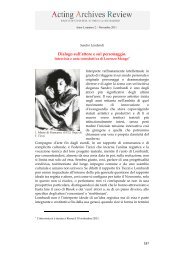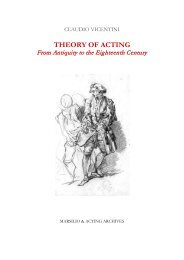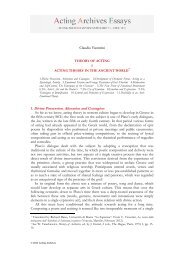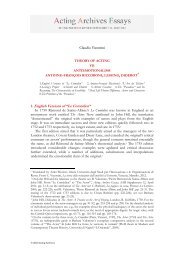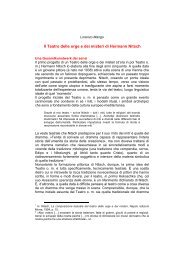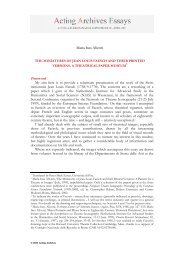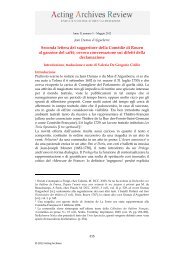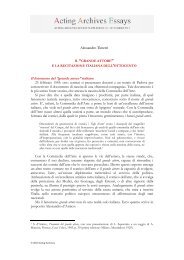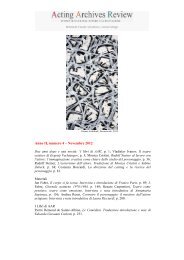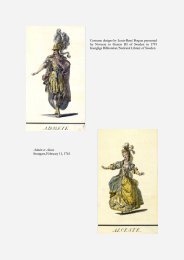Flavia Pappacena_Noverre's Lettres sur la Danse - Acting Archives
Flavia Pappacena_Noverre's Lettres sur la Danse - Acting Archives
Flavia Pappacena_Noverre's Lettres sur la Danse - Acting Archives
You also want an ePaper? Increase the reach of your titles
YUMPU automatically turns print PDFs into web optimized ePapers that Google loves.
AAR <strong>Acting</strong> <strong>Archives</strong> Essays Supplement 9 – April 2011<br />
compositional criteria – rapidity and <strong>sur</strong>prise – enabled him on one hand to keep the<br />
spectator in a constant state of agitation, a prey to emotions, and on the other to<br />
create set pieces which were homogeneous and well ba<strong>la</strong>nced in terms of visual<br />
impact, gesture and sound. Rapidity involved brief scenes and a swift evolution in the<br />
situations (as Noverre put it in Letter XIV, 1760: each scene was to be as quick as a<br />
f<strong>la</strong>sh of lightning). To en<strong>sur</strong>e <strong>sur</strong>prise Noverre often had recourse to coups de théâtre<br />
and both visual and aural special effects (such as miraculous apparitions).<br />
Among the elements of <strong>sur</strong>prise, silence and vocal interjections are among the<br />
most original and evocative solutions. In Letter XIV Noverre asserts that he<br />
introduced silences as early as 1757 in La Toilette de Vénus, exp<strong>la</strong>ining that it was an<br />
ingenious expedient to make the audience concentrate on what was happening on<br />
stage and appreciate the perfect composition of the tableau vivant with its air of<br />
solemn calm. Whereas when it comes to the tragic ballets he composed in Stuttgart<br />
and Vienna, silence has a dramatic function which can be compared to its role in<br />
theatrical idiom, serving to underscore key moments in the drama and to emphasise<br />
the moral message. 73 In Les Horaces et les Curiaces (II, 1), for example, the silence<br />
bestows solemnity on the oath of loyalty taken by the King of Rome, Tullus, and the<br />
King of Alba, Metius, in front of their armies drawn up prior to battle. In the second<br />
scene of the first part of Hypermnestre the appearance of the menacing spectre of<br />
Ge<strong>la</strong>nor to Danaus is made all the more terrifying by silence, amidst which the<br />
lugubrious words ‘Frémis Tyran, <strong>la</strong> mort t’attend’, pronounced by a singer hidden<br />
among the group of sculptures from which the spectre emerges, announces the<br />
tyrant’s pending downfall. 74 Later on, two passages described by Noverre illustrate a<br />
vocal interjection realised in the same ballet by means of a chorus off stage.<br />
if on his [Danaus’s] departure daylight returns, and with the dawn a fearful hubbub is<br />
heard expressing regret, remorse and grief (cries uttered by a women’s chorus); if at this<br />
very moment the curtain parts again and the Danaïdes, hair flying, arms steeped in<br />
blood and grasping daggers, are seen fleeing the scene of their misdeeds, pursued by the<br />
ghosts of their husbands, the furies, and personifications of crime, remorse and<br />
vengeance […] the spectator will not be able to stand the sight of so many excruciating<br />
tableaux without being cut to the quick. 75<br />
Another vocal interjection, this time used to evoke Greek tragedy, occurs in La<br />
Mort d’Agamemnon. When Clytemnestra is accidentally stabbed by Orestes, the chorus<br />
says: ‘quel horreur! quel crime affreux! ah dieux’, 76 going on to address Orestes with<br />
the words: ‘Monstre, c’est ta mère! Tremble, frémis, oh épuvantable! fuyons,<br />
73 It is very likely that Noverre took his cue from the importance that was attributed to silence in the<br />
stage p<strong>la</strong>y tradition. See Jean-François Marmontel, ‘Déc<strong>la</strong>mation théâtrale’ and Denis Diderot, Réponse<br />
à <strong>la</strong> lettre de Mme Riccoboni.<br />
74 1804, t. IV, part I, scene II, p. 186.<br />
75 ‘si à son départ [de Danaus] le jour paroît, et qu’au lever de l’aurore on entend des cris confus et<br />
effrayants poussés par les remords, le repentir et <strong>la</strong> doleur; (cris prononcés par un chœur de femmes)<br />
que dans cette instant, on voye les rideaux s’ouvrir encore et les Danaïdes les cheveux épars, les bras<br />
sang<strong>la</strong>nts et armés de poignards fuir le lieu de leurs forfaits, si on les voit poursuivies par les spectres<br />
de leurs époux, par les furies, les crimes, les remords, et <strong>la</strong> vengeance personnifiés […] il n’est plus<br />
possible que le spectateur puisse soutenir <strong>la</strong> vue de tant tableaux déchirants, sans être vivement ému’.<br />
1803, t. II, Letter XVI, p. 162.<br />
76 Ibid., p. 167.<br />
22



